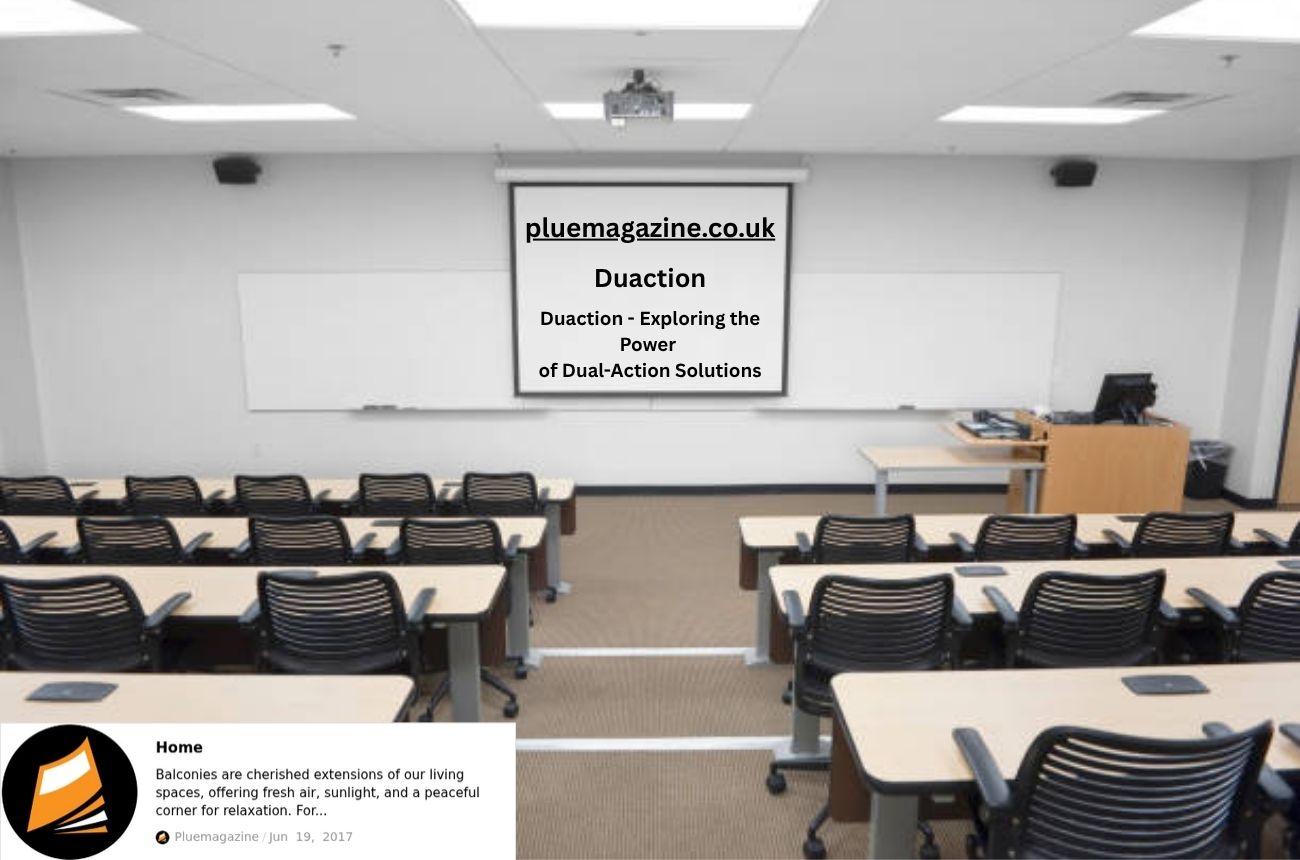Guide
How Duaction Is Revolutionizing Education Modern Classrooms

In today’s rapidly changing educational landscape, traditional teaching methods are being challenged by new approaches that prioritize collaboration, engagement, and real-world application. One of the most promising of these methods is Duaction—a progressive learning concept that integrates dual modes of learning: doing and understanding. The term “Duaction” is derived from “dual action,” symbolizing the harmony between active participation and conceptual comprehension. This innovative model is revolutionizing how students learn, educators teach, and institutions evaluate success.
Duaction represents a paradigm shift away from rote memorization toward applied knowledge. It combines the analytical side of theory with the experiential depth of hands-on practice, making learning more dynamic and impactful for modern classrooms.
Understanding the Core Concept of Duaction
At its core, Duaction emphasizes the importance of learning through interaction and reflection. It’s not merely about introducing new technology or software into classrooms—it’s about transforming the learning experience. Students engage in activities that challenge them to think critically, collaborate, and apply their knowledge in real-world scenarios.
This approach acknowledges that understanding a concept in theory is incomplete unless one can implement it practically. Duaction bridges this gap by merging cognitive learning (knowing) with kinesthetic learning (doing). The result is an educational framework that nurtures not only academic growth but also emotional intelligence, creativity, and problem-solving ability.
The Historical Background: How Duaction Emerged
The idea of Duaction didn’t appear overnight. It evolved from decades of educational research exploring active learning, dual processing, and experiential methodologies. Early educational theorists like John Dewey and Jean Piaget championed the notion that students learn best by doing. However, Duaction takes this further by systematizing the process into structured modules that ensure equal emphasis on both theory and application.
By the 2020s, advances in digital learning platforms and hybrid classrooms provided the perfect environment for Duaction to flourish. Educators began integrating this dual-action approach into both physical and online learning settings, proving that knowledge retention and student engagement increased dramatically when learners participated actively in their education.
How Duaction Works in Modern Classrooms
In practice, Duaction operates through a carefully designed blend of lectures, discussions, experiments, projects, and reflection sessions. Teachers no longer act solely as information providers but as facilitators guiding students toward discovery.
For example, in a Duaction-based science class, a student learns about photosynthesis theoretically and then applies that understanding by growing plants under varied conditions to observe real outcomes. In mathematics, abstract concepts like probability are reinforced through real-life simulations and data analysis exercises. This hands-on approach helps students develop a holistic understanding of each subject.
Technological Integration and Digital Tools
Modern classrooms are embracing technology as an integral part of the Duaction model. Interactive whiteboards, virtual laboratories, simulation software, and AI-powered tutors are revolutionizing how learning takes place. These digital tools allow students to experiment without fear of failure, encouraging curiosity and innovation.
For instance, Duaction platforms can track a student’s performance during interactive modules, offering real-time feedback that helps learners improve both understanding and execution. This technological synergy ensures that every student experiences personalized learning at their own pace, bridging the gap between traditional and digital education.
Benefits of Duaction for Students

The advantages of Duaction extend far beyond higher grades. Students engaged in dual-action learning develop confidence, adaptability, and intrinsic motivation. They learn how to collaborate with peers, manage projects, and approach problems from multiple perspectives.
Moreover, Duaction nurtures critical thinking skills and emotional resilience. Because students are consistently exposed to real-world challenges, they learn how to handle uncertainty and failure constructively. This prepares them for life beyond the classroom—where adaptability and problem-solving are key to success.
Impact on Teachers and Educators
Educators also benefit tremendously from the Duaction framework. It empowers teachers to shift from monotonous lecturing to meaningful mentorship. Teachers can observe firsthand how students engage with concepts, enabling them to tailor their instruction to different learning styles.
Additionally, Duaction promotes continuous professional development among teachers. Since the method encourages innovation, educators are motivated to stay updated with the latest research and digital tools. This cultivates a culture of lifelong learning within educational institutions.
Institutional Transformation through Duaction
At the institutional level, Duaction encourages a systemic transformation in curriculum design, assessment methods, and resource allocation. Traditional grading systems are gradually being replaced by performance-based evaluations that assess both process and outcome. Schools implementing Duaction have reported improved retention rates, higher engagement, and more positive classroom environments.
Moreover, institutions adopting this model tend to form stronger partnerships with industries and communities. These collaborations allow students to engage in internships, research projects, and real-world problem-solving, which further enhance their learning experience.
Challenges in Implementing Duaction
While the benefits are undeniable, implementing Duaction presents several challenges. Resistance to change remains a significant barrier, especially in institutions rooted in traditional methodologies. Teachers require proper training to adopt this approach effectively, and infrastructural upgrades—such as access to digital tools—can be costly.
Furthermore, assessing performance under the Duaction model requires a fundamental rethinking of evaluation criteria. Balancing theoretical examinations with practical performance assessments demands time, planning, and institutional support.
Duaction and the Role of AI in Personalized Learning

One of the most exciting developments within Duaction is the integration of artificial intelligence. AI helps in customizing the learning journey for each student, identifying strengths and weaknesses in real time. Adaptive algorithms can suggest additional resources, generate practice exercises, or adjust lesson difficulty levels based on performance.
This technological alignment ensures inclusivity, catering to students with diverse abilities and learning paces. It transforms the once-linear classroom structure into a dynamic and responsive environment that mirrors how individuals naturally learn.
Global Adoption and Future Prospects
Duaction is not confined to one region—it is gaining traction globally. From European universities to Asian high schools, educators are exploring how this model fits into their national education systems. The versatility of Duaction makes it adaptable across cultures and disciplines.
Looking ahead, experts predict that Duaction could become the foundation for the future of hybrid education. As society continues to emphasize practical skills, creativity, and adaptability, the demand for such integrative learning frameworks will only grow.
Success Stories from Duaction Classrooms
Several schools and universities that implemented Duaction have reported impressive results. For instance, students demonstrated better retention rates and increased participation in problem-solving discussions. One school noted a 25% improvement in project outcomes after switching to dual-action modules.
In business education, students using Duaction-based learning modules performed better in simulations that required decision-making under pressure. Such findings underline that Duaction is not just a theoretical concept—it’s a transformative movement shaping the future of global education.
Conclusion
In conclusion, Duaction represents a revolutionary shift toward holistic, inclusive, and effective learning. By merging theory and practice, it addresses one of the most significant flaws in traditional education—the gap between knowledge and application. It empowers students to learn actively, think critically, and act confidently in real-world situations.
As classrooms continue to evolve, Duaction stands at the forefront of this transformation. It’s more than a method—it’s a mindset that redefines what it means to educate and be educated in the modern world.
FAQs
1. What is the primary goal of Duaction in education?
The main goal of Duaction is to integrate theory with practice, allowing students to understand concepts deeply and apply them in real-life contexts. This dual approach ensures holistic learning that enhances both intellectual and practical skills.
2. How does Duaction differ from traditional teaching methods?
Traditional methods often emphasize passive learning through lectures and memorization. Duaction, in contrast, promotes active engagement, collaboration, and experiential projects, which help learners connect knowledge with real-world applications.
3. Can Duaction be applied in digital learning environments?
Absolutely. Duaction works exceptionally well in digital or hybrid settings. Through tools like virtual simulations, online projects, and interactive software, students can engage with content actively, regardless of physical classroom boundaries.
4. What challenges might teachers face when adopting Duaction?
Educators may face initial difficulties adapting to the dual-action model due to a lack of training, time constraints, or limited digital infrastructure. However, with proper institutional support and resource allocation, these challenges can be overcome.
5. What is the future potential of Duaction in global education?
Duaction has vast potential to redefine education globally. As technology continues to evolve and practical skills become more valuable, Duaction’s integration of doing and learning positions it as a cornerstone of modern education systems.
-

 Celebrity8 months ago
Celebrity8 months agoWho Is Elizabeth Buckley Harrold O’Donnell? A Closer Look at Lawrence O’Donnell’s Family
-

 Celebrity8 months ago
Celebrity8 months agoNathaniel Mandrell Dudney: Insights into Barbara Mandrell’s Family Life
-

 Celebrity8 months ago
Celebrity8 months agoWho Is Vera Davich? A Deep Dive into Her Life and Relationship with Scott Patterson
-

 Celebrity8 months ago
Celebrity8 months agoTalia Elizabeth Jones: Exploring Her Connection to Davy Jones
















